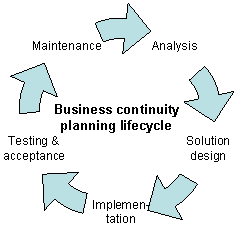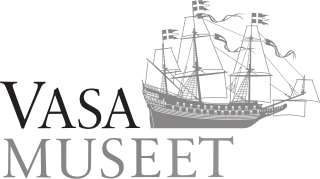
Risk management is the identification, evaluation, and prioritization of risks followed by coordinated and economical application of resources to minimize, monitor, and control the probability or impact of unfortunate events or to maximize the realization of opportunities.

The history of Stockholm, capital of Sweden, for many centuries coincided with the development of what is today known as Gamla stan, the Stockholm Old Town. Stockholm's raison d'être always was to be the Swedish capital and by far the largest city in the country.

Business continuity may be defined as "the capability of an organization to continue the delivery of products or services at pre-defined acceptable levels following a disruptive incident", and business continuity planning is the process of creating systems of prevention and recovery to deal with potential threats to a company. In addition to prevention, the goal is to enable ongoing operations before and during execution of disaster recovery. Business continuity is the intended outcome of proper execution of both business continuity planning and disaster recovery.

Vasa or Wasa is a Swedish warship built between 1626 and 1628. The ship sank after sailing roughly 1,300 m (1,400 yd) into her maiden voyage on 10 August 1628. She fell into obscurity after most of her valuable bronze cannons were salvaged in the 17th century, until she was located again in the late 1950s in a busy shipping area in Stockholm harbor. The ship was salvaged with a largely intact hull in 1961. She was housed in a temporary museum called Wasavarvet until 1988 and then moved permanently to the Vasa Museum in the Royal National City Park in Stockholm. The ship is one of Sweden's most popular tourist attractions and has been seen by over 35 million visitors since 1961. Since her recovery, Vasa has become a widely recognized symbol of the Swedish Empire.

The Swedish Navy is the naval branch of the Swedish Armed Forces. It is composed of surface and submarine naval units – the Fleet – as well as marine units, the Amphibious Corps.

Baron Carl Carlsson Gyllenhielm was a Swedish soldier and politician. He was made a baron (friherre) in 1615, appointed Field Marshal in 1616, Privy Councilor in 1617, Governor General of Ingria in 1617 and served as Lord High Admiral from 1620 until his death.

A project manager is a professional in the field of project management. Project managers have the responsibility of the planning, procurement and execution of a project, in any undertaking that has a defined scope, defined start and a defined finish; regardless of industry. Project managers are first point of contact for any issues or discrepancies arising from within the heads of various departments in an organization before the problem escalates to higher authorities, as project representative.
Crisis management is the process by which an organization deals with a disruptive and unexpected event that threatens to harm the organization or its stakeholders. The study of crisis management originated with large-scale industrial and environmental disasters in the 1980s. It is considered to be the most important process in public relations.
The following outline is provided as an overview of and topical guide to software engineering:

The MS Estonia was a cruiseferry built in 1980 for the Finnish company Rederi Ab Sally by Meyer Werft, in Papenburg, West Germany. She was employed on ferry routes between Finland and Sweden by various companies until 1993, when she was sold to Nordström & Thulin for use on Estline's Tallinn–Stockholm route. The ship's sinking on 28 September 1994, in the Baltic Sea between Sweden, Finland and Estonia, was one of the worst peacetime maritime disasters of the 20th century, claiming 852 lives.
An organizational structure defines how activities such as task allocation, coordination, and supervision are directed toward the achievement of organizational aims.

The Vasa Museum is a maritime museum in Stockholm, Sweden. Located on the island of Djurgården, the museum displays the only almost fully intact 17th-century ship that has ever been salvaged, the 64-gun warship Vasa that sank on her maiden voyage in 1628. The Vasa Museum opened in 1990 and, according to the official website, is the most visited museum in Scandinavia. Together with other museums such as the Stockholm Maritime Museum, it belongs to the Swedish National Maritime Museums (SNMM).

Kronan, also called Stora Kronan, was a Swedish warship that served as the flagship of the Swedish Navy in the Baltic Sea in the 1670s. When built, she was one of the largest seagoing vessels in the world. The construction of Kronan lasted from 1668 to 1672 and was delayed by difficulties with financing and conflicts between the shipwright Francis Sheldon and the Swedish admiralty. After four years of service, the ship foundered in rough weather at the Battle of Öland on 1 June 1676: while making a sharp turn under too much sail she capsized, and the gunpowder magazine ignited and blew off most of the bow. Kronan sank quickly, taking about 800 men and more than 100 guns with her, along with valuable military equipment, weapons, personal items, and large quantities of silver and gold coins.
Software project management is the process of planning and leading software projects. It is a sub-discipline of project management in which software projects are planned, implemented, monitored and controlled.

Henrik Hybertsson was a Dutchborn master shipbuilder working in the Stockholm navy yard in the early 17th century. He is mostly known for being the designer and constructor of the warship Vasa, which sank on its maiden voyage in 1628 and is now on display at the Vasa Museum.

Carl Gustaf Anders Franzén was a Swedish marine technician and an amateur naval archaeologist. He is most famous for having located the 1628 wreck of the Swedish galleon Vasa in 1956 and participated in her salvage 1959–1961. He also participated in the exploration for the wrecks of Swedish warships Kronan, Riksäpplet and Resande Man as well as Gustav Vasa's flagship Lybska Svan.

Clas Larsson Fleming was an Swedish naval officer and nobleman involved in the development of a formal management structure for the Swedish Navy during the reigns of King Gustavus Adolphus and Christina, Queen of Sweden. He is remembered as one of the ablest administrators in the history of the Swedish Navy, and is in many ways a typical example of the type of aristocrat who served the Swedish Crown during the period of Sweden's imperial expansion.
The Mary Rose Trust is a limited charitable trust based in Portsmouth in the United Kingdom. Its primary aims are to preserve, display and spread knowledge about the 16th century warship Mary Rose which sank in the Solent on 19 July 1545 and was salvaged by the Trust in October 1982.

The Dalarö wreck is a shipwreck of a 17th-century ship lying in the waters off Edesön near Dalarö, southeast of Stockholm, Sweden. It is the remains of a three-masted armed vessel. It was discovered in 2003 but it was not made public until March 2007.

Shipwrecking is an event that causes a shipwreck, such as a ship striking something that causes the ship to sink; the stranding of a ship on rocks, land or shoal; poor maintenance, resulting in a lack of seaworthiness; or the destruction of a ship either intentionally or by violent weather.













